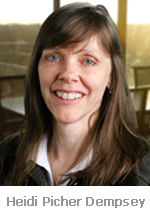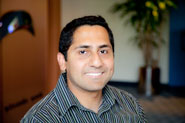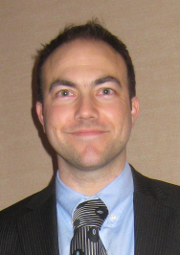| Version 4 (modified by , 10 years ago) (diff) |
|---|
GEC 21 Evening Demo Session
Location
Cyberinfrastructure Building
2709 East 10th Street
Bloomington, IN 47408
http://it.iu.edu/cib/
Schedule
Tuesday Oct 21, 5:30p - 7:30p
Session Leaders
 |
 |
 |
| Heidi Picher Dempsey GENI Project Office |
Manu Gosain GENI Project Office |
Peter Stickney GENI Project Office |
Details
The evening demo session gives new and existing GENI experimenters and projects a chance to share their work in a live network environment. Demonstrations run for the entire length of the session, with teams on hand to answer questions and collaborate. This page lists scheduled demonstrations categorized in broad interest groups.
Directions and Logistics
Please visit Directions and Logistics for attendee and presenter logistics information.
Projects
Infrastructure and Measurement
GENI Shakedown Expimeriments -- Intelligent Data Movement Service (IDMS)
Intelligent data management service is dynamic storage and networking solution. It is deployed in GENI to evaluate performance. In this demonstration, we are extending our previous stitched shared-vlan experiment with meso-scale openFlow experiment spread across uh-eg, gpo-eg and fiu-eg. Two experiment are connected to each other using Layer 3 router deployed in VM at Illinois-ig. We will also be deploying Phoebus Gateways on backbone for external access to the experiment.
Participants:
- Akshay Dorwat, adorwat@umail.iu.edu, Indiana Univ.
- Ezra Kissel, ezkissel@indiana.edu, Indiana Univ.
Experiments and Education
A networked Virtual Reality based training environment for orthopedic surgery
This demonstration focuses on a GENI based collaborative Virtual Reality based training environment for orthopedic surgery. A network based collaborative approach has been implemented outlined which enables distributed training of medical students from different locations. The virtual surgery environment is being remotely operated with the aid of a redundancy server.
Participants:
- Oklahoma State
- Parmesh Ramanathan, parmesh@ece.wisc.edu, Univ. of Wisconsin-Madison
Jacks
Jacks is a new way to allocate and view your resources. It is embeddable in many contexts and is becoming more capable every day. The new features we wish to showcase are multi-aggregate support, a constraints system that helps users avoid topologies that can't work, and deeper integration of the editor into both Apt and the GENI Portal.
Participants:
- Jonathon Duerig, duerig@flux.utah.edu, Univ. of Utah
- Rob Ricci, ricci@cs.utah.edu, Univ. of Utah
GENI Desktop
GENI Desktop provides a unified interface and environment for experimenters to create, control, manage, interact with and measure the performance of GENI slices. This demo will show the newly implemented functions in the GENI Desktop. We enhanced the GENI Desktop to use Speaks-for credentials for accessing resources from other GENI components on behalf of users. We improved the user interface based on feedback from last GEC. We will demo the initial version of the slice verification testing and the revised archival service implemented in GENI Desktop. In addition, we will demo the module for supporting user-defined routes implemented in the Adopt-A-GENI (AAG) project. This demo is suitable to GENI experimenters (beginners and experienced) who want to learn how to manage/control their experiments and interact with GENI resources. It may be also interesting to GENI tool developers who want to see how GENI Desktop uses the Speaks-for credential to interact with other GENI components.
Participants:
- Jim Griffioen, griff@netlab.uky.edu, Univ. of Kentucky
- Zongming Fei, fei@netlab.uky.edu, Univ. of Kentucky
- Hussamuddin Nasir, Hussamuddin Nasir, Univ. of Kentucky
Simulation-As-A-Service App
We will demonstrate new configuration of our simulation-as-a-service (SMaaS) App that involves TotalSim using GENI for PaaS experiments, which will enable them to deliver their App (that has data-intensive computation and data movement workflows) in SaaS form to their customers. We will have a new Layer 2 tunneling setup from demo site to the TotalSim office in Dublin, OH. We will also show ontology integration for a collaboration use case in advanced manufacturing. Gigabit App developers and cloud infrastructure engineers will particularly find our demo interesting.
Participants:
- Prasad Calyam, calyamp@missouri.edu, Univ. of Missouri
Sea-Cloud Innovation Environment
The aim of the Sea-Cloud Innovation Environment , which is a national wide testbed, is to build an open, general-purpose, federated and large-scale shared experimental facility to foster the emergence of next generation information technology research in China. The demo presents experiment service system, resource control system and measurement system in the Sea-Cloud Innovation Environment. The hardware and distributed end-to-end Openflow testbed update is also introduced. At the same time, some new features in our system is presented this demo as following: experiment workflow control program based on Java & Python language, experiment visualization, light-weight VM management tool, and so on.
Participants:
- Xiaodan Zhang, zhangxiaodan@cstnet.cn, Chinese Academy of Sciences
GENI Cinema
GENI Cinema is a live video streaming project under development by Clemson University and the University of Wisconsin. The goal is to allow users in the GENI community to host live events and allow other users to tune-in. The infrastructure is implemented using GENI resources at various GENI aggregates, and OpenFlow is used extensively within the GENI aggregates to provide a seamless and scalable streaming service to the end user, who can simply leverage the service via a web browser. The demonstration at GEC21 will show how multiple users can provide live video streams to the GENI Cinema service, and it will show how subscribers viewing a stream can easily switch from one feed to the next without breaking their sockets.
Participants:
- Ryan Izard, Ryan Izard, Clemson Univ.
- Kuang-Ching Wang, Kuang-Ching Wang, Clemson Univ.
- Joseph Porter, jvporte@g.clemson.edu, Clemson Univ.
- Benton Kribbs, bkribbs@g.clemson.edu, Clemson Univ.
- Qing Wang, qw@g.clemson.edu, Clemson Univ.
- Aditya Prakash, aprakash6@wisc.edu, University of Wisconsin-Madison
- Parmesh Ramanathan, parmesh@ece.wisc.edu, Univ. of Wisconsin-Madison
Network Functions Virtualization using ProtoRINA
Network Functions Virtualization (NFV) aims to implement network functions as software instead of dedicated physical devices (middleboxes), and recently it has attracted a lot of attention. NFV is inherently supported by our RINA architecture, and a Virtual Network Function (VNF) can be easily added onto existing networks. In this demo, we demonstrate how ProtoRINA can be used to support RINA-based NFV.
Participants:
- Ibrahim Matta, matta@bu.edu, Boston University
Federation / International Projects
VNode, FLARE, SDX
We will show our recent progress of VNode system, especially focusing on applications working over VNode system. In GEC21, we are preparing three demos: one for dynamic software function deployment in virtual network for video streaming service (demo1), second for FLARE and network service deployment demo (demo2), and third for federation between different virtualization platforms (demo3).
demo1: Dynamic software function deployment in virtual network will be demonstrated, and video streaming via virtual network will be shown, and the streaming will be transcoded automatically when network congestion occurs.
demo2: In FLARE demo, the updated application driven networking will be shown. In network service deployment demo, it will be shown that the service created by the Click based network design tool is automatically deployed over the network virtualized slice. It is also shown in the live demo that the service deployment, start, and stop can be executed by one command.
demo3: Federation between SDX and VNode is demonstrated. Developers interested in application-driven network should see this demo. Developers interested in SDX or international/heterogeneous virtual network should also see this demonstration, because it will show VNode-SDX federation.
Participants:
- Univ. of Tokyo
- Akihiro Nakao, nakao@iii.u-tokyo.ac.jp
- Shu Yamamoto, shu@iii.u-tokyo.ac.jp
- Toshiaki Tarui, toshiaki.tarui.my@hitachi.com, Hitachi
Wireless Projects
Vehicular Sensing and Control
This demo mainly focuses on newly developed mechanisms for enhancing the performance of the VSC platform as well as latest achievements developed for Vehicular Sensing and Control (VSC) platform based applications. Specifically, this demo will demonstrate 1) virtualization of camera sensing and vehicle internal sensing, and 2)VSC application-layer emulation with camera sensing using the GENI WiMAX network and ExoGENI racks. Additionally, the extended communication capability of the VSC platform to both local users and remote users will be demonstrated via wirover box when the vehicle is moving out of the coverage of the GENI WiMAX network. Developers and researchers interested in vehicular sensing and control network, resource virtualization, and real-time communication should stop by this demo since we would like to share our experiences and learn from your valuable suggestions.
Participants:
Attachments (19)
-
GEC21poster-V3.pdf (760.4 KB) - added by 10 years ago.
Geni_Connected_Vehicles
-
NFV-ProtoRINA-GEC21Poster.pdf (477.7 KB) - added by 10 years ago.
NFV using ProtoRINA
-
gec21-poster-primogeni.pdf (1.8 MB) - added by 10 years ago.
PrimoGENI Constellation
-
gec21-poster-myexp.pdf (1.4 MB) - added by 10 years ago.
PrimoGENI MyExperiment
-
GENIdesktop_poster_gec21.pdf (631.7 KB) - added by 10 years ago.
GENI Desktop Demo at GEC21
-
gec21-demo.pdf (2.2 MB) - added by 10 years ago.
Dynamic Virtual Router Failure Recovery
-
GEC21_DynamicDMZ.pdf (1.0 MB) - added by 10 years ago.
Size-based Flow Management Enabling Dynamic DMZ
-
GEC21_OntologyIntegration-poster.pdf (1.2 MB) - added by 10 years ago.
Simulation-As-A-Service App
-
XIA-As-A-Research-Platform-Poster.pdf (329.5 KB) - added by 10 years ago.
XIA As A Research Platform
-
SID_poster_GENI.pdf (571.5 KB) - added by 10 years ago.
Implementing Service Routing Over XIA
- GENI-SDX-Poster-GEC21.pdf (1.9 MB) - added by 10 years ago.
-
GEC21-2014-Poster-v3.pdf (303.5 KB) - added by 10 years ago.
Hadoop-in-a-hybrid-cloud poster
-
GEC21_DataPlanePerformanceCharacterization.pdf (185.1 KB) - added by 10 years ago.
GEC21_DataPlanePerformance
-
GEC21_Hadoop.pdf (759.9 KB) - added by 10 years ago.
Hadoop Network Characterization
-
GEC21_NCI.pdf (851.3 KB) - added by 10 years ago.
NCI poster pdf
-
GEC21_NetworkDebug.pdf (773.4 KB) - added by 10 years ago.
network debugging
-
GEC21 VehicularSensingandControl- Wayne.pdf (2.0 MB) - added by 9 years ago.
Vehicular Sensing and Control
- GEC21_poster_GENI_over_air.pdf (333.6 KB) - added by 9 years ago.
-
GEC21_GENI_Cinema_Poster.pdf (945.3 KB) - added by 9 years ago.
GENI Cinema Poster
